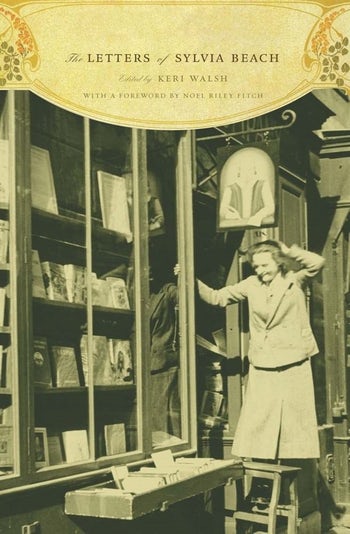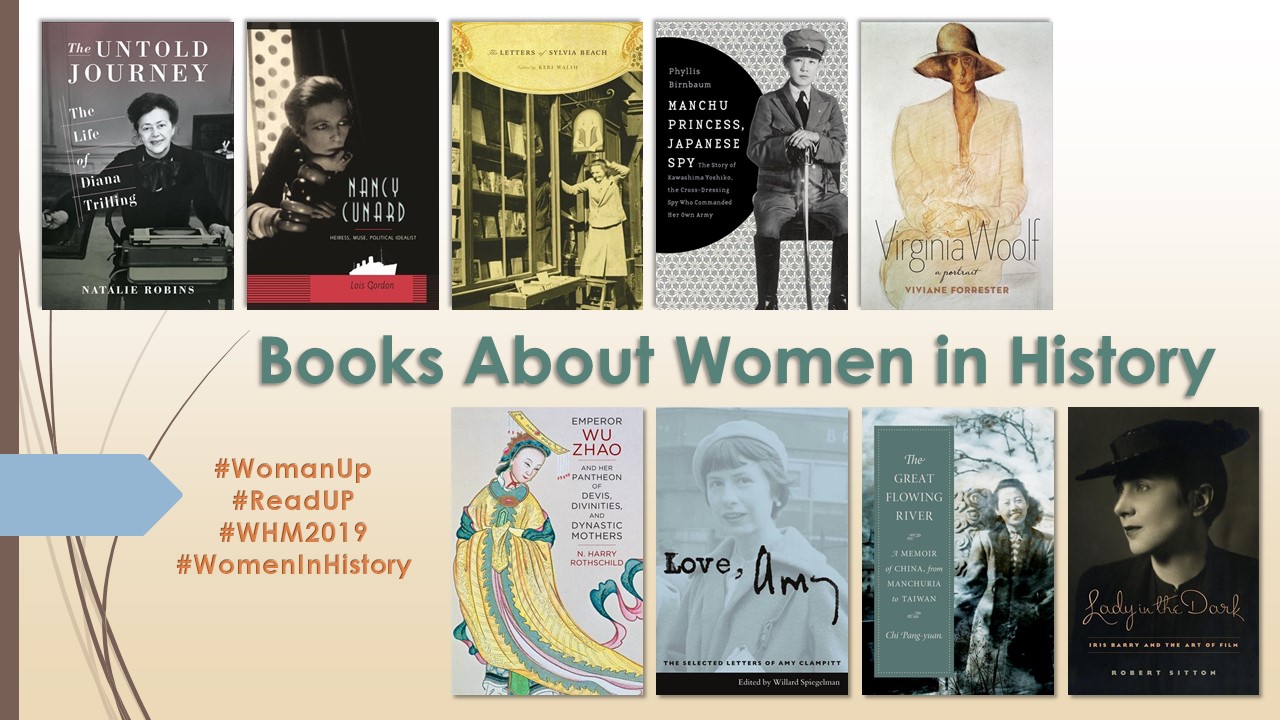The Last Days of Shakespeare and Company

“This lovely book, scholarly and well annotated, is a pleasure to hold. It documents what Beach once called ‘my missionary endeavor’ and also what she called, correctly, her ‘interesting life.’”
~Dwight Garner, New York Times
November 19, 2019 marks the 100th anniversary of Sylvia Beach’s original Shakespeare and Company, a legendary bookstore that drew in friends and clients such as Ernest Hemingway, Gertrude Stein, and Ezra Pound. In celebration of this centennial anniversary, editor of The Letters of Sylvia Beach, Keri Walsh is sharing this brief history of the last days of Shakespeare and Company and Beach’s life after the store’s closing.
• • • • • •
A century ago this November, on a quiet Paris street called rue Dupuytren, Sylvia Beach opened her English-language bookstore Shakespeare and Company. Soon, Beach moved to a more central location on the rue de l’Odéon, in the shadow of the Odéon theatre. Her warmth and wit were immortalized by Ernest Hemingway in A Moveable Feast: he was one of her most loyal customers of the 1920s. Soon, Beach expanded Shakespeare and Company’s operations to include the care and feeding of James Joyce, including publishing the first edition of Ulysses. Joyce’s Mediterranean blue tome appeared in 1922, at the height of literary modernism, but what happened to Beach after the celebrated interwar period for which she is best known? She stayed in Paris for the rest of her life, long after most expatriates of the Twenties had gone home, and she continued to contribute to Paris’s intellectual culture in a variety of ways.
In her 1959 memoir Shakespeare and Company, Sylvia Beach gave an account of the last days of her legendary modernist bookshop. The “last days” arrived in 1941 when a German officer of the Occupation arrived at her door and attempted to buy a copy of Finnegans Wake. Beach refused to sell it to him. The same officer returned two weeks later, threatening to confiscate all of her goods. What followed was her decision to rapidly shut up her shop. In a mere two hours, the rich terrain of Shakespeare and Company, the twenty-two year old institution where Joyce had spent most of his afternoons in the nineteen-twenties, where Hemingway and Fitzgerald had found an American home room, and where Stein and Toklas had borrowed books and sometimes exchanged barbs, was gone. Beach narrates the sudden disappearance of her shop from the streets of Occupied Paris as though it were the breaking down of a theater set. She received her landlady’s approval to store her inventory and furniture in a vacant third floor apartment, and with the help of her assistants, she took down the shelves and painted the storefront over. The proprietor herself disappeared as well, moving to the Students’ Hostel on Boulevard St. Michel. In Shakespeare and Company, Beach recounts these events with a certain degree of wit and levity—always her preferred modes—and she doesn’t end her memoir there—rather, she jumps forward to conclude with Hemingway’s arrival at war’s end to “liberate” the rue de l’Odéon, She leaves her readers with a pleasing final image—Hemingway’s promise that his next stop would be to “liberate” the cellar at the Ritz, an image that suggested that the expatriate magic of 1920s Paris could simply be picked up where it had been left off.
“In a mere two hours, the rich terrain of Shakespeare and Company, the twenty-two year old institution where Joyce had spent most of his afternoons in the nineteen-twenties, where Hemingway and Fitzgerald had found an American home room, and where Stein and Toklas had borrowed books and sometimes exchanged barbs, was gone.”
But of course, this was far from the truth. Beach’s idyllic vision of the 1920s in Shakespeare and Company, like Hemingway’s characterization of Paris as a “moveable feast,” could only be imagined at the horizon of the permanent loss of this world. Beach was not the only writer or cultural figure to present an idealized version of Paris at war’s end, rather than to engage with the much more difficult reality. There was a desire, coming both from France and from its Allies, to skip immediately from the painful realities of reckoning and reconstruction to a utopian retrospective vision of France. This desire stemmed from a weariness of war and a desire to help France get back on its feet and start receiving visitors, expats, and GI Bill students again. French photographer Robert Doisneau’s images for Life magazine similarly presented a timeless and idealized vision of French life—lovers kissing outside the Hotel de Ville, children running through the streets with baguettes under their arms, while 1951’s Best Picture winner An American in Paris associated Paris with painting, love, and ballet rather than collaboration, gunfire, and exhaustion.
As an American national who did not flee France during the war, despite the pleas of her Embassy to do so, and as a staunch anti-fascist who had come to the assistance of Jewish friends including Walter Benjamin, Gisèle Freund, and Arthur Koestler during the war, Beach knew that France in the late 1940s and early 1950s was more complicated than the paradise for GIs that Hollywood made it out to be. She had known serious hardships during the war. She was interned in a camp at Vittel for 6 months in 1942, and she had also spent time hiding out in a friend’s home in the Loire that had been stocked with provisions for her survival. In one of the rarer realistic moments of her memoir, Beach narrates a day near the end of the war when she and her life partner Adrienne Monnier came out in the streets to celebrate the certainty of Allied Victory, only to have to drop to their bellies and crawl away in terror as German machine gun fire rang out. After the trials of the war years, Beach emerged into the political, moral, and economic chaos of France of the late 1940s and early 1950s—collaborationist trials, strikes, floods, shortages of everything. When she took a brief hiatus from Europe to visit America in the early 1950s she was overwhelmed by the seeming comfort and carelessness of New York, writing to Monnier that she was “uplifted” by Manhattan, “by the lively and clear colors of persons, buildings, restaurants, taxis, sky and sidewalks.” But Beach, a devoted Parisian, would always return to her adopted hometown.
“In one of the rarer realistic moments of her memoir, Beach narrates a day near the end of the war when she and her life partner Adrienne Monnier came out in the streets to celebrate the certainty of Allied Victory, only to have to drop to their bellies and crawl away in terror as German machine gun fire rang out.”
Shakespeare and Company had closed in 1941, and when the war was over, Beach gave varying accounts for not reopening the business. To Dorothy Pound she wrote that the “bookshop went under,” a statement that had a certain degree of truth given how difficult it had proven to keep it profitable throughout the lean 1930s. To the American Library of Paris, to whom she donated her lending library’s collection in 1951, she explained that she could not re-open the shop “for reasons of health.” This too had a certain truth: she was sixty at the war’s end, she had long suffered from debilitating migraines, and Monnier’s health was in more serious decline. So while Shakespeare and Company was gone for good—that is, until the name was taken up by George Whitman and applied to his own bookstore (the one that is still in Paris today)—Sylvia Beach had nearly two decades still to live, and in that time she divided her energies between two activities—looking backwards to curate the legacy of the 1920s, and looking forward, as she had always done, to try to understand and support developments in the literary world.
Because she had been the first publisher of Ulysses, Beach possessed a substantial number of Joyce manuscripts and materials, and of course she herself was a primary source for biographers and scholars. She became a key custodian of the work of Joyce, but she also felt marginalized by the increasing scholarly investment in his work. In the years following his death in 1941 Joyce was becoming increasingly identified with the academy and the so-called “Joyce Industry” was born. As a lifelong idealist with a non-profit spirit and little in the way of retirement savings, Beach found it necessary to make money by selling her Joyce collection. She looked to American university libraries for a buyer, eventually choosing SUNY Buffalo for a majority of her Joyce manuscripts. From them, in addition to funds, she received an honorary degree in a ceremony alongside fellow recipient Robert Moses in 1959. Although her personal relationship with Joyce had ended in estrangement when Joyce sold the rights to Ulysses to Random House in the mid-1930s, after his death she continued to admire and promote him, and also to care for Nora and Lucia Joyce, whose health and financial situations she followed with concern.
“Beach had always prided herself on being a self-educated amateur, and during this period her anti-academic sentiments grew stronger as she contended with a rising tide of Joyce scholars seeking access to her manuscripts and materials while not always showing her the respect she felt she deserved.”
Beach had always prided herself on being a self-educated amateur, and during this period her anti-academic sentiments grew stronger as she contended with a rising tide of Joyce scholars seeking access to her manuscripts and materials while not always showing her the respect she felt she deserved. One scholar in particular became her nemesis—Joseph Prescott, author of 1964’s Exploring James Joyce. At first Beach found him charming, but she soon revised her impression. She wrote to Harriet Shaw Weaver that his expectations of access to her collection, no matter the inconvenience to her, made him “exceedingly aggressive and indiscrete, trying to force someone who has been given the privilege of studying a private collection in her own home, to sacrifice her convenience to his ambitious schemes.” She calls his methods “more those of a go-getting businessman than of a scholar.” Her annoyance with Prescott led to a rift with Harriet Weaver as well, since it was Weaver, Joyce’s key benefactor and a very wealthy woman, who had suggested that Beach allow Prescott access to her manuscripts. Beach wrote to Weaver drawing attention to the difference between their financial situations and explaining the fact that she relied on this material for her future financial security. She complained of Prescott’s tantrums, telling Weaver that when she took time away from Paris to travel and did not allow him access to the collection during her absence, he accused her of “ruining his whole academic career.”
As her distrust of scholars escalated, Beach more than ever propounded a view of Joyce as an accessible writer, bucking the notion of modernist difficulty with which his work was increasingly becoming associated. On a visit to Ireland she said how interesting it was to hear Joyce read from his work and to hear him discuss it. She mentioned that she thought Joyce would have been amused and befuddled to hear what they thought he meant. In the face of increasingly complex Joycean hermeneutics, she took care to emphasize those parts of Joyce’s writing that tended toward simplicity. She insisted to her interlocutors in Ireland and elsewhere that Joyce prized ordinariness and went to great lengths to hide his learning from people. He also enjoyed explaining his work to ordinary people. He would never make such people feel like “ignoramuses,” she insisted, with the insinuation that the Joseph Prescotts of the world were doing so.
Beach’s curation of Joyce’s reputation was not the only legacy work she did in this period. In 1959 artifacts from her collection were featured in an American Embassy exhibition in Paris called Les Années Vingts, and she travelled frequently, giving talks, appearing on the radio, and enjoying the role of a beloved American cultural ambassador who had shown true love for France. While at Yale in the 1950s she saw an exhibition dedicated to the works of H.D., and wrote to her old friend to tell her “how thrilling I found your exhibition at Yale. These are the only real events in our funny little life.” In the pages of Shakespeare and Company, she did much to consolidate her legend with charming, irreverent anecdotes about her patrons and friends.
“In the face of increasingly complex Joycean hermeneutics, she took care to emphasize those parts of Joyce’s writing that tended toward simplicity. She insisted to her interlocutors in Ireland and elsewhere that Joyce prized ordinariness and went to great lengths to hide his learning from people.”
But while few tastemakers had been so successful at creating their own legend, Beach was not content to spend all of her time looking to the past. Throughout the war she had kept up with American literature, and had opinions about what needed to be done to promote it abroad. She suggested the need for French translations of Steinbeck’s The Grapes of Wrath and Marjorie Rawlings’s The Yearling. She befriended Richard Wright and spent Christmas of 1947 with his family: in a letter to him she shared political sympathies of the left and informed him that French readers had been tremendously interested in the appearance of “Black Boy” in Sartre’s publication “Les Temps Modernes,” and were eagerly awaiting the coming translation of Native Son. She had always been interested in avant-gardes, and in the late 1940s she was one of the most-qualified people to predict literature’s next frontier. But in the cultural fragmentation and disarray of the immediate post-war, even she seemed uncertain of the future. Since the mid-1930s, in George Orwell’s assessment, it had been hard to say which way the literary tides were blowing. In “Inside the Whale,” he opined on “the impossibility of any major literature until the world has shaken itself into a new shape.” For Sylvia Beach in the years after World War II, it was not entirely clear either, but one fact she seemed willing to bet on was that the future would be French.
In 1947, her longtime friend André Gide won the Nobel Prize. Beach writes of seeing Gide “chuckling” to witness his book Corydon—a series of socratic dialogues defending homosexuality—with “Prix Nobel written across their bellyband in large letters” and she told a friend that “his American royalties are in the shape of a large comfortable car in which he visits the rue de l’Odeon.” Gide’s breakthrough in America was of a piece with the general craze for French literature in America after the war, when the works of Sartre, Camus, and De Beauvoir, as well as the dramas of Jean Anouilh and Jean Genet were embraced as the avant-garde. Beach, who had previously spent most of her time introducing English-language writers in France (she and Monnier had published the first French translation of Eliot’s The Love Song of J. Alfred Prufrock, for instance) now threw herself into the reverse process of introducing a promising French writer to English speaking audiences. In 1949 she translated Henri Michaux’s A Barbarian in Asia, which she called “one of the masterpieces of French literature,” for New Directions, a translation for which she won the Denyse Clairoun Prize. A Barbarian in Asia was a chronicle of Michaux’s travels through India, China, Japan, and elsewhere in Asia, and showed a turn toward the East that would become increasingly compelling to western writers and artists of the post-war. Written in a proto-psychedelic style, the book lauded the anti-colonial commitments and non-violent techniques of Gandhi.
“She decried gentrification, which she said was ‘happening all over Paris now. They buy up all these old houses where the rents of the apartments are still very low because you are not allowed to increase them, and then they give the tenant a chance to buy his apartment. But at a huge sum! If you haven’t the money, you get out. I haven’t. So it looks as if he will get me out.’”
At the end of her life, Beach was still living in the apartment above the former premises of Shakespeare and Company, and railing against property speculation in the neighborhood that was threatening to drive her, and other renters, out. An article in the Manchester Guardian of 1962 quoted her and described the scene: “‘I won’t get out. I will not!’ Sylvia sat up in her highbacked chair and thumped the armrests vigorously with her fists; her eyes, alert and quick as a teenager’s, darted around the cluttered room looking for someone to glare at. ‘What does a man want with 500 houses? He can’t live in them all.’” She decried gentrification, which she said was “happening all over Paris now. They buy up all these old houses where the rents of the apartments are still very low because you are not allowed to increase them, and then they give the tenant a chance to buy his apartment. But at a huge sum! If you haven’t the money, you get out. I haven’t. So it looks as if he will get me out.” As it turned out, Beach died in her sleep before she was forced to move, in October of 1962, in her mid-seventies.
One of her last adventures was a trip to Greece with the French poet Yves Bonnefoy and other friends. Later, Bonnefoy wrote a Surrealistic memoir of their travels together, describing how Beach, fueled by caffeine, was indefatigable in Greece, taking a torch down a long staircase into a well, seeing a likeness of Joyce’s furrowed brow in a museum’s classical statue, and devastated when the weather turned in a way that prevented a visit to Ithaca. “Sylvia in Greece was tireless and beyond fatigue,” wrote Bonnefoy of Beach’s voyage, near the end of her life, to the Homeric landscape that had inspired Joyce. Bonnefoy’s memoir recalls photographs he took of Beach in Delphi, where she appeared to him as a kind of oracle, “present to the most vital developments of an epoch.”
Save 30% on this or any of our books when you order from our website by using coupon code: CUP30 at checkout!






